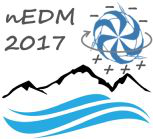Speaker
Dr
arnaud leredde
(LPSC, Université Grenoble-Alpes)
Description
In the scope of the n2EDM experiment, aiming for a sensitivity of $σ_{d_n }=1×10^{-27}$e.cm, the precise measurement of the magnetic field and its gradients is critical. Taking advantage of the gravitational shift between the neutrons and the mercury atoms of the co-magnetometer to correct for the false EDM induced by the relativistic motional field, this problem reduces to the knowledge of the $γ_n/γ_{Hg}$ at the 0.2ppm level. This ratio has already been measured at the 0.8ppm level [1] in the nEDM apparatus and will be improved by the n2EDM setup to the 0.1ppm level. As a sanity check, necessary in case of discovery of an EDM at the $10^{-27}$e.cm level, this ratio can also be inferred by combining the independent measurements of $γ_n$ and $γ_{Hg}$ in different conditions. $γ_n$ itself is known with a precision of 0.24 ppm [2], and the mercury-199 magnetic moment has been measured by Cagnac in the 1960’s [3] at the level of 1.7ppm which has to be improved. The hopeless goal of creating an homogeneous and stable magnetic field at the 0.1ppm level leaves us with the only option of measuring $γ_{Hg}$ using a co-magnetometer. 4He has been chosen has the second specie for this co-magnetometer since its magnetic moment is already known to better than 0.1ppm. For the mercury magnetometer, a frequency-quadrupled laser will provide the 254 nm light necessary to pump and probe the atoms. A Bell-Bloom scheme will be used for the pumping and the precession frequency will be measured by the modulated absorption of the probe beam. The helium part, designed by our collaborators at CEA-Leti, Grenoble (France), will use a well-established technique for helium magnetometry [4,5]. The preliminary tests and the expected sensitivity will be presented at the workshop.
[1] Afach, Phys. Lett. B 738 (2014)
[2] Greene, Phys. Rev. D 20 (1979)
[3] Cagnac, Ann. Phys. 6 (1961)
[4] Guttin, J. de Phys. IV, vol. 4, no. C4 (1994)
[5] Weis, Phys. Rev. A, vol. 74, no. 3 (2006)
| leredde@lpsc.in2p3.fr |
Primary author
Dr
arnaud leredde
(LPSC, Université Grenoble-Alpes)

